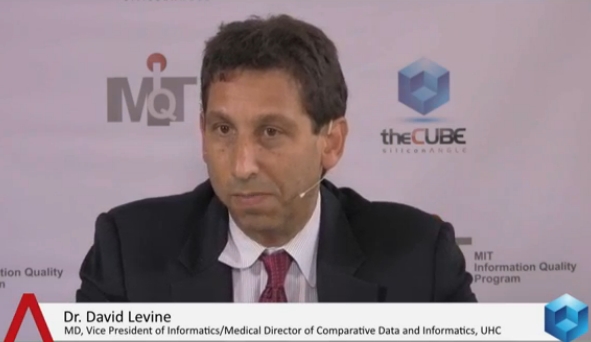 NEWS
NEWS
 NEWS
NEWS
 NEWS
NEWS
![]() Dave Vellante and Jeff Kelly, theCube co-hosts, went to Cambridge, Massachusetts, to cover this year’s Chief Data Officer and Information Quality (CDOIQ) Symposium, taking place from July 17 to 19 in the MIT campus. The event strives to bring together practitioners, vendors and educators in the field of Information Quality.
Dave Vellante and Jeff Kelly, theCube co-hosts, went to Cambridge, Massachusetts, to cover this year’s Chief Data Officer and Information Quality (CDOIQ) Symposium, taking place from July 17 to 19 in the MIT campus. The event strives to bring together practitioners, vendors and educators in the field of Information Quality.
Among the attendees was David Levine, MD, Vice President of Informatics and Medical Director of Comparative Data and Informatics with UHC. Naturally, because of his position, the chat gravitated to aspects of information quality with focus on its application within the healthcare ecosystem.
Levine has the role of overseeing the risk adjustment process. The company risk-adjusts for patient mortality, length of stay, and direct costs for academical medical centers. “Since it’s a very specialized patient population, it warrants the ability to look at that population and capture those risks where the clinicians will both believe in the data and be able to take action on the data,” said Levine. His role, apart from risk adjustment, is to also engage clinicians in the data, creating new tools for them to use, and working with Chief Medical Officers to save live, decrease complications, in the most efficient way possible.
For this event, Levine was asked to give a presentation on the Evolution of the UHC risk models. “There’s a different number of risk adjustment methodologies out there, but UHC’s risk adjustment, by being specialized for the most complex patients in the healthcare setting, has really continued to evolve as data has evolved over the years.” Ten-to-fifteen years ago, the data was limited; in time, UHC has worked to improve the quality of its risk predictions and the usability of the models both on the data quality and the face validity and the users’ ability to believe the data and take actions based on it.
Vellante wanted to hear the webtrends that Levine has observed in this time of data monitoring, from the days when data was not that big, until now. In the past, said Levine, there were hassles managing even small amounts of data. “It was really tough trying to measure it, and there were small measurements that could be done, like patient mortality or the length of stay. Even cost data was really hard to capture the individual data elements.”
See the full interview below:
Levine jokes that “true cost has been the toughest nut to crack” in the medical field, and the main issues include the quality of the databases and their ability to exchange information. Tying individual things to individual patients has proven to be very tough. Data explosion didn’t ensure that hospitals had systems that talked to each-other in a consistent fashion.
Vellante and Kelly picked up on the trend that, in healthcare, systems do not talk to each other and wanted to hear more about this issue, and Levine’s experience in the field. It turns out that all information regarding the patient is now present on admission, not some time after, having a direct impact on mortality.
It’s not just empty facts, said Levine. He stressed that “All of our data elements have at least one drill-down.” The role of the CDO (Chief Data Officer) is bringing data from different data streams together and linking databases. But also filtering what’s important and what not, not keeping all the data just because they have it.
THANK YOU